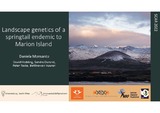- ALSA Home
- →
- Documents
- →
- Research Events
- →
- View Item
JavaScript is disabled for your browser. Some features of this site may not work without it.
| dc.contributor.author | Monsanto, Daniela | |
| dc.contributor.author | Hedding, David | |
| dc.contributor.author | Durand, Sandra | |
| dc.contributor.author | Teske, Peter | |
| dc.contributor.author | Van Vuuren, Bettine | |
| dc.date.accessioned | 2022-08-17T15:26:28Z | |
| dc.date.available | 2022-08-17T15:26:28Z | |
| dc.date.created | 2022-08-01 | |
| dc.identifier.uri | http://hdl.handle.net/123456789/28780 | |
| dc.description.abstract | Focus has been drawn to fine-scale molecular work and its value in conservation biology has been highlighted. Previous research on sub-Antarctic Marion Island has found that landscape and climatic barriers across the island shape spatial genetic patterns. However, the relative importance that fi ne-scale habitat heterogeneity plays in shaping the local-scale movement of individuals has received little attention on Marion Island. Therefore, we examine the fi ne-scale spatial genetic structure (SGS) of the springtail, Cryptopygus antarcticus travel (Class: Collembola) on Marion Island. Using a species-specific suite of microsatellite markers, we explored genetic patterns for two one-kilometre-long sampling transects that were designed to investigate the influence of landscape features. Our results revealed the presence of genetic clusters across these landscape features, with gene flow being in the direction of the island’s prevailing wind. Notably high levels of genetic diversity were discovered, which is in line with what is expected for the Class. Relatedness was determined to break down at approximately 150 m, and geographical distance in combination with roughness indices is responsible for shaping spatial patterns in the region. These findings allude to past historical and geological events which have left imprints on the current fi ne-scale SGS of springtails. These spatial patterns could be driven by micro-habitat preferences and/or a fitness funnel driven by local adaptations, which indicate that individuals do respond to environmental change. Our results may bring about far-reaching implications for conservation management on Marion Island, highlighting the importance of considering fine-scale evolutionary processes in management plans. | en_ZA |
| dc.description.sponsorship | Sponsored by the the Department of Science and Innovation(DSI) through National Research Foundation (NRF) - South Africa | en_ZA |
| dc.description.statementofresponsibility | Antarctic Legacy of South Africa | en_ZA |
| dc.language | English | en_ZA |
| dc.publisher | Scientific Committee on Antarctic Research (SCAR) | en_ZA |
| dc.relation | SCAR 10th Open Science Conference - 2022 | |
| dc.rights | Copyright | en_ZA |
| dc.subject | Research - Biology | en_ZA |
| dc.subject | Research - Zoology | en_ZA |
| dc.subject | Research - Botany | en_ZA |
| dc.subject | Research | en_ZA |
| dc.title | Landscape Genetics Of A Springtail Endemic To Marion Island | en_ZA |
| dc.type | Presentation | en_ZA |
| dc.rights.holder | Daniela Monsanto | en_ZA |
| iso19115.mdconstraints.uselimitation | This item and the content of this website are subject to copyright protection. Reproduction of the content, or any part of it, other than for research, academic or non-commercial use is prohibited without prior consent from the copyright holder. | en_ZA |
| iso19115.mdidentification.deliverypoint | Antarctic Legacy of South Africa, Faculty of Science, Private Bag X1, Matieland. Stellenbosch. South Africa. | en_ZA |
| iso19115.mdidentification.electronicmailaddress | antarcticlegacy@sun.ac.za | en_ZA |
Files in this item
This item appears in the following Collection(s)
-
Research Events [501]
Material directly related to official scientific and research events

